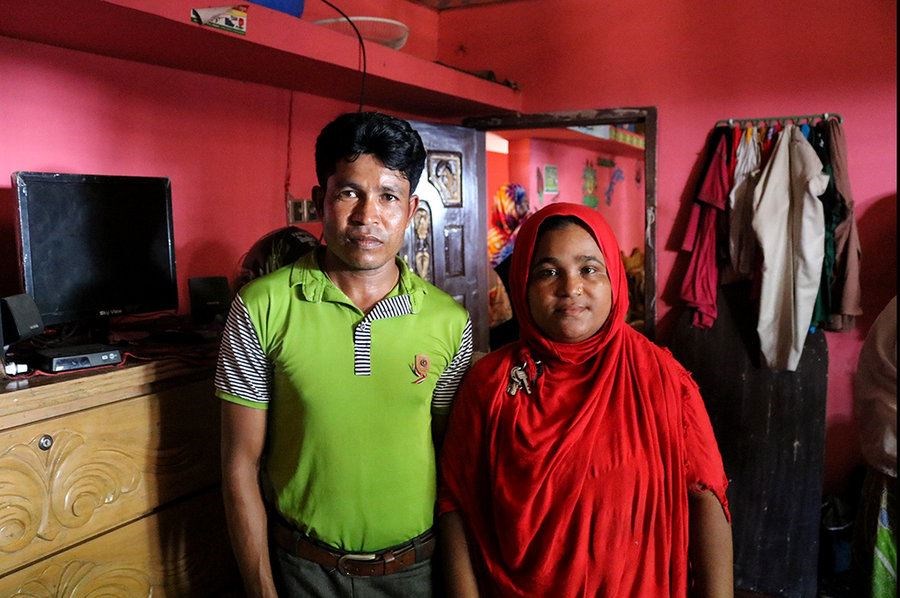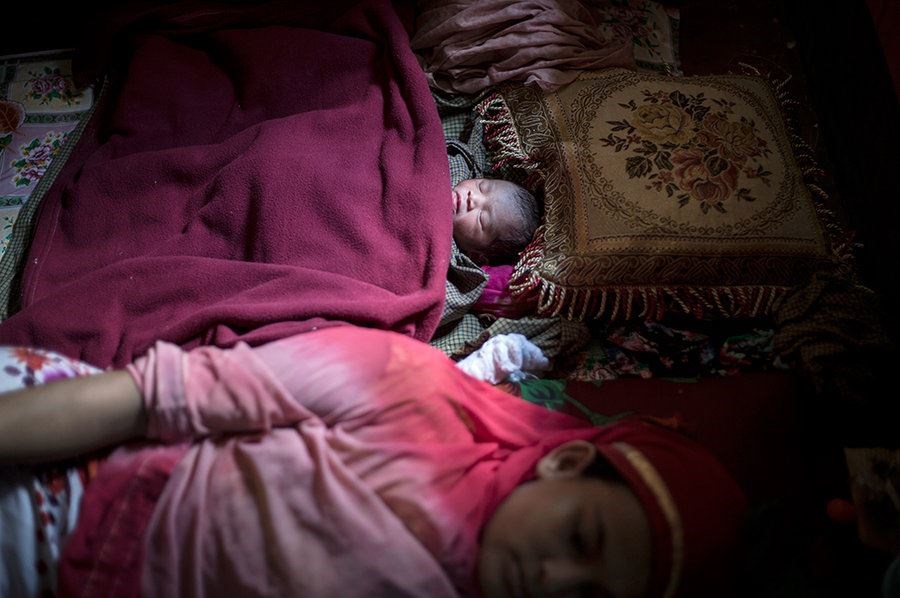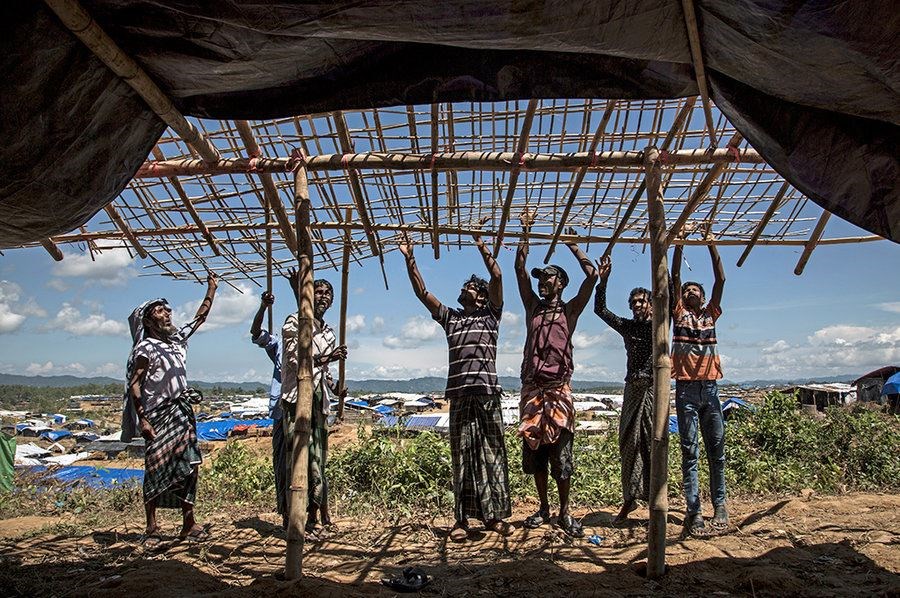Permission to use this
material was granted by
The Christian Science Monitor
Residents of Bangladesh, one of the poorest nations in Asia, are scrambling to provide hundreds of thousands Rohingya refugees pouring over their border with some semblance of normalcy.
 Haroon Roshid and his wife, Khaleda Begum, help Rohingya refugees fleeing the violence in neighboring Myanmar. Micheal Holtz / The Christian Science Monitor Michael Holtz
Haroon Roshid and his wife, Khaleda Begum, help Rohingya refugees fleeing the violence in neighboring Myanmar. Micheal Holtz / The Christian Science Monitor Michael Holtz
BALUKHALI, BANGLADESH—When hundreds of thousands of Rohingya refugees began fleeing from Myanmar into Bangladesh six weeks ago, Haroon Roshid and his wife, Khaleda Begum, gave them what little they could: water, rice, plastic tarpaulins.
Their supplies quickly ran out. Then, last week, a local Islamic charity asked to use their house as a makeshift hospital. They didn’t hesitate to say yes. Their living room – its walls painted bright pink – became a delivery room, their muddy front yard a pharmacy.
A team of volunteer doctors soon arrived and helped deliver five babies in three days. Outside, thousands of sick and injured refugees received medicine.
“They are human beings just as we are,” Mr. Roshid says, standing next to his wife in their bedroom. She nods in agreement. “Our house is open to them for as long as they need,” he continues. “If the doctors stay forever, that is no problem for us.”
Behind the couple’s generosity lies Roshid’s own experience. He has been a Rohingya refugee himself since 2000, when he fled violence in neighboring Myanmar for safety in Bangladesh, just as his Muslim compatriots are fleeing their burning villages now.
He has since found work as an electrician and, six years ago, married Ms. Begum, a local Bangladeshi woman. Together they live with their four children on what was once the outskirts of the Balukhali refugee camp. Their concrete house now sits well inside the makeshift camp’s rapidly expanding boundaries, surrounded by tens of thousands of refugees who are living with nothing to protect them from the rain except plastic tarps hung over shaky bamboo poles.
As Roshid and Begum tell their story, a pregnant woman arrives at the front door. She is about to go into labor. Begum runs to the kitchen to grab fresh water while two doctors help the woman onto a bed in the living room. Another woman lies on the floor next to her newborn baby.
“We’re doing all we can to help,” Roshid says with a look of exhaustion. “There are just too many people.”
Roshid isn’t the only one feeling overwhelmed. Since late August, when soldiers and Buddhist mobs in Myanmar began burning Muslim Rohingya villages, more than half a million Rohingya are reported to have fled into Bangladesh, creating the largest refugee crisis to hit Asia in decades.
Bangladeshi authorities say the flow of refugees has greatly slowed in the past two weeks. Still, humanitarian groups are struggling to keep up with the demands of those who had already arrived. The United Nations World Food Program has appealed for $75 million in emergency aid over the next six months.
"The bottom line? This is a deplorable situation,” David Beasley, executive director of WFP, told reporters after visiting some of the camps in Bangladesh. “This is as bad as it gets.”
Bangladesh is one of the poorest countries in Asia, and this crisis has stretched the nation to its limit. As the government, the UN, and other nongovernmental organizations scramble to respond, long-time refugees and local villagers have shown remarkable kindness in their efforts to help fill in some of the gaps.
“I saw what was happening on Facebook and decided to come,” says Joshaim, a fisherman from the port city of Chittagong, 100 miles north of the camps. He came with 1,500 taka, about $18, to hand out to refugees. “I know it’s not much,” he says as he walks along a muddy path through Balukhali. “I just wanted to help.”
This is not the first time Rohingya have poured into Bangladesh. They have suffered from bursts of violence at government hands for nearly 40 years, and each outbreak has provoked a wave of refugees. Even before the current crisis, some 500,000 Rohingya had lived in camps like Balukhali and neighboring Kutupalong for decades.
But the events of the past six weeks have been on a different scale. The UN’s top human rights official has called it “a textbook example of ethnic cleansing.”
The current crisis began on Aug. 25, when Rohingya militants attacked about 30 police posts and an Army base in Myanmar’s western state of Rakhine, killing at least 12 members of the security forces. The Myanmar military launched a brutal “clearance campaign” in response, forcing people from their homes by burning them down.
Satellite images obtained by Human Rights Watch show the near-total destruction of 284 villages across northern Rakhine.
The Rohingya claim a long history in Myanmar that traces back to at least the 15th century. But the government of the Buddhist-majority country says they are illegal immigrants from Bangladesh. They have long been denied citizenship and basic rights, living under conditions many observers have compared to apartheid. Their rights to marry and to have children are restricted by the government, and many have been confined to their villages since an attack by militants a year ago on security forces.
Many analysts, including the UN special human rights investigator in Myanmar, Yanghee Lee, have suggested that the government – strongly influenced by the military despite being headed by Nobel Peace Prize winner Aung San Suu Kyi – plans to drive the Rohingya out completely.
“For the Army, this is unfinished business,” says Phil Robertson, deputy director of Human Rights Watch’s Asia pision. “It wants them out of the country.”
The military may be seizing its chance. The government has done nothing to rein in its violent campaign, and though international pressure is mounting, it may prove to be too little, too late.
More than 500,000 Rohingya have fled to Bangladesh in the past six weeks, according to UN estimates. An unknown number of other victims have been killed in the violent crackdown.
Fires are no longer visible from the Bangladeshi side of the border, but refugees who crossed over in late September said the military and allied mobs were still burning down homes – sometimes with families inside. The parents of Jani Alam, a 19-year-old Rohingya man who had just crossed the border when I met him last week, suffered such a fate, he said.
Shirtless and starving, Mr. Alam was walking with three other men along the road that led from the border to the sprawling refugee camps. Each of them looked as if he could collapse at any moment. They said they had spent the previous four days hiking barefoot through the forest, crossing two rivers on their journey.
“I’m very happy to be in Bangladesh,” Alam says. “Now I’m finally safe.”
 Ahmer KhanA mother and her newborn baby, named Zainab, take shelter inside a house owned by Haroon Roshid and his wife, Khaleda Begum. Their house was being used as medical clinic, and several babies were delivered here.The new refugee camps across the border from Myanmar in southern Bangladesh stretch for miles in every direction. Before Aug. 25, tree-covered hillsides were dotted with lush rice paddies. Today, the slopes have been denuded of all but the largest trees, and covered instead by a rain-lashed city built from tarpaulins and bamboo, wallowing in a sea of mud.
Ahmer KhanA mother and her newborn baby, named Zainab, take shelter inside a house owned by Haroon Roshid and his wife, Khaleda Begum. Their house was being used as medical clinic, and several babies were delivered here.The new refugee camps across the border from Myanmar in southern Bangladesh stretch for miles in every direction. Before Aug. 25, tree-covered hillsides were dotted with lush rice paddies. Today, the slopes have been denuded of all but the largest trees, and covered instead by a rain-lashed city built from tarpaulins and bamboo, wallowing in a sea of mud.
Entrepreneurial locals have set up food stalls along the main roads and crowded paths. (The prices of bananas, rice, and vegetables have all doubled since the refugees started to arrive.) UN and non-governmental aid workers have set up medical tents, food distribution centers, and even a hilltop cemetery. They are building latrines as fast as they can to ward off cholera. UNICEF, the UN children's agency, plans to build more than 1,300 schools over the next year, since 60 percent of the refugees are children.
The conditions in the camps are dismal. Frequent rains turn the dirt roads into rivers of mud and sewage. Children swim in streams of murky brown water to cool off in the tropical heat. But despite the palpable sense of desperation, many refugees are already trying to carve out new lives for themselves.
Zakid Hossain, a 25-year-old man who arrived in Balukhali five weeks ago with his mother and wife, has opened a small shop along one of the camp’s main arteries. He sold his wife’s gold earrings to buy an assortment of cigarettes, dried snacks, and fresh vegetables from a wholesale market in a nearby town, which he sells at a markup. His shop is nothing more than a black tarp on which he can sit and display his goods.
“I don’t know how many days or months or years I will stay here, so I decided to open the shop,” says Mr. Hossain, who previously worked as a day laborer in Myanmar. “If I earn money, I will use it to buy food for my family. We’re in God’s hands now.”
If history is any guide, Hossain and his fellow refugees won’t be returning to Myanmar anytime soon. While the Bangladeshi government has said it hopes that Myanmar will eventually repatriate them, the authorities there have said that they will accept only those with documents proving they have a right to return. Few refugees have such papers, either because they were never issued, or because they lost them in the chaos of their sudden exodus.
 Ahmer KhanPeople in Kutupalong refugee camp build a new mosque.As the new refugees struggle to piece together some semblance of a normal life, mosques have started to sprout up alongside the schools and roadside stalls. Some have been paid for by Bangladeshi donors, others by long-time camp residents.
Ahmer KhanPeople in Kutupalong refugee camp build a new mosque.As the new refugees struggle to piece together some semblance of a normal life, mosques have started to sprout up alongside the schools and roadside stalls. Some have been paid for by Bangladeshi donors, others by long-time camp residents.
The refugees build most of the mosques with the same materials they use for their homes: strips of bamboo are woven into walls, and plastic tarps serve as roofs. Without electricity or loudspeakers to broadcast the call to prayer, muezzins must rely on the strength of their own voices for the five-times-a-day ritual.
Abu Sallhe, an Arabic teacher from Rakhine who fled to Bangladesh in 1992, donated money to pay for a mosque on a hill that overlooks one of the sprawling camps. He and a few relatives started work on it two weeks ago. “In times like this, it’s important to have a place to pray,” Mr. Sallhe says.
On a recent afternoon, Sallhe was resting beneath the tarpaulin roof of the partially finished mosque with a half dozen refugees who had volunteered to help build it. The heat made it too difficult to work in long stretches. They needed a break.
As they sat in the shade, the new arrivals shared tales about their journeys to Bangladesh and about their lives back home. Their villages had all been burned and most had lost loved ones at the hands of the military, they said. This was their new home, and they saw the mosque as an integral part of it.
“It makes me feel proud to help build this mosque,” said Zafor Hossain, who had been living in the camp for two weeks with his wife and two teenage sons. “Now I just pray that God will help us.”
Permission to use this
material was granted by
The Christian Science Monitor
Page created on 12/18/2017 10:40:06 PM
Last edited 12/20/2017 7:37:15 AM
